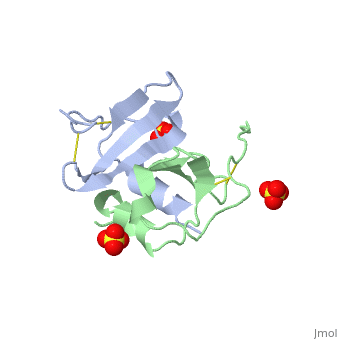C-X-C motif chemokine
From Proteopedia
| Line 18: | Line 18: | ||
**[[3n52]] – mCXCL – mouse<br /> | **[[3n52]] – mCXCL – mouse<br /> | ||
**[[1mi2]] – mCXCL – NMR<br /> | **[[1mi2]] – mCXCL – NMR<br /> | ||
| + | |||
| + | *CXCL5 | ||
| + | |||
| + | **[[2mgs]] – hCXCL – human – NMR<br /> | ||
*CXCL10 | *CXCL10 | ||
| - | **[[1lv9]] – hCXCL | + | **[[1lv9]] – hCXCL – NMR<br /> |
**[[1o7z]], [[1o7y]], [[1o80]] – hCXCL<br /> | **[[1o7z]], [[1o7y]], [[1o80]] – hCXCL<br /> | ||
**[[2r3z]] – mCXCL <br /> | **[[2r3z]] – mCXCL <br /> | ||
Revision as of 11:40, 19 March 2015
| |||||||||
| CXCL12α dimer complex with sulfate, 1qg7 | |||||||||
|---|---|---|---|---|---|---|---|---|---|
| Ligands: | |||||||||
| |||||||||
| |||||||||
| Resources: | FirstGlance, OCA, PDBsum, RCSB | ||||||||
| Coordinates: | save as pdb, mmCIF, xml | ||||||||
C-X-C motif chemokine (CXCL) are small chemokines.
• CXCL2 or MIP-2 or imacrophage inflammatory protein 2 acts as chemotactic for polymorphonuclear leukocytes and hematopoietic stem cells.
• CXCL10 or IP-10 or interferon γ-induced protein 10 acts as chemoattractant for monocytes, T cells NK cells and dendritic cells. CXCL10 binds to the cell surface receptor CXCR3.
• CXCL11 or IP-9 or interferon γ-induced protein 9 acts as chemotactic for activated T cells.
• CXCL12 or Stromal-Derived-Factor-1 (SDF1) has a role in angiogenesis, tumor metastasis and the migration of cells from the liver to the bone marrow during embryogenesis.
• CXCL14 or BRAK acts as chemotactic for monocytes and inhibits angiogenesis.
3D Structures of C-X-C motif chemokine
Updated on 19-March-2015


